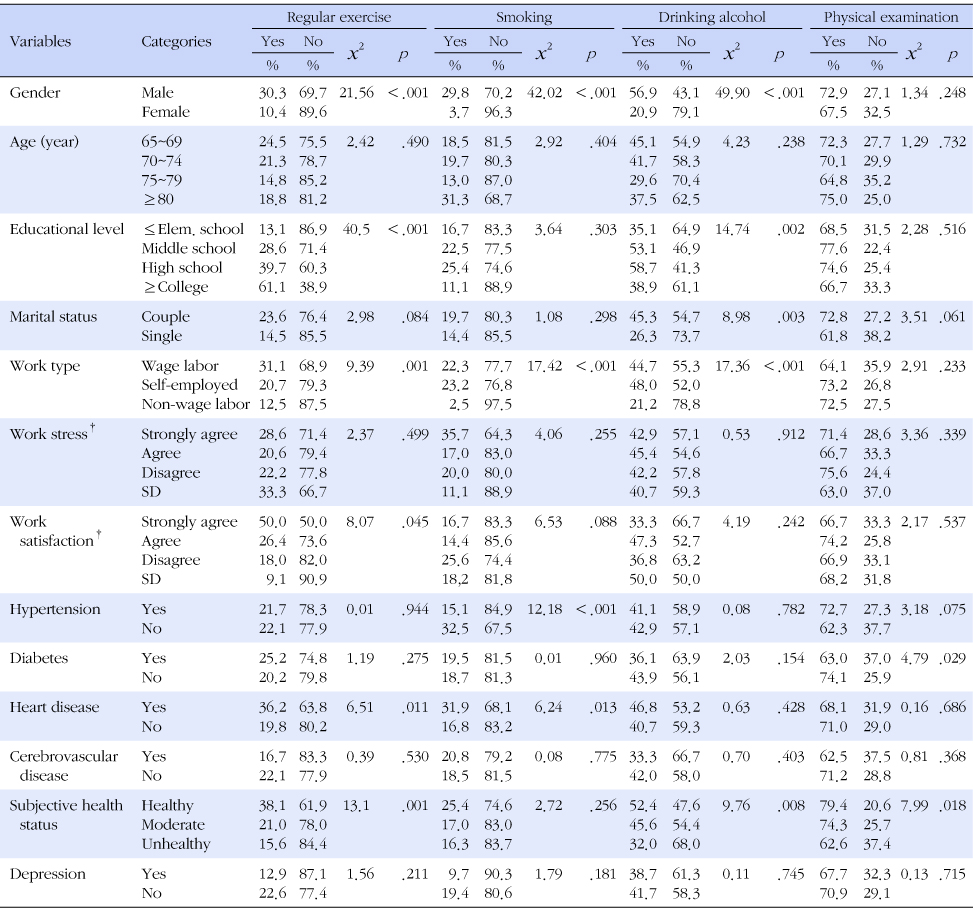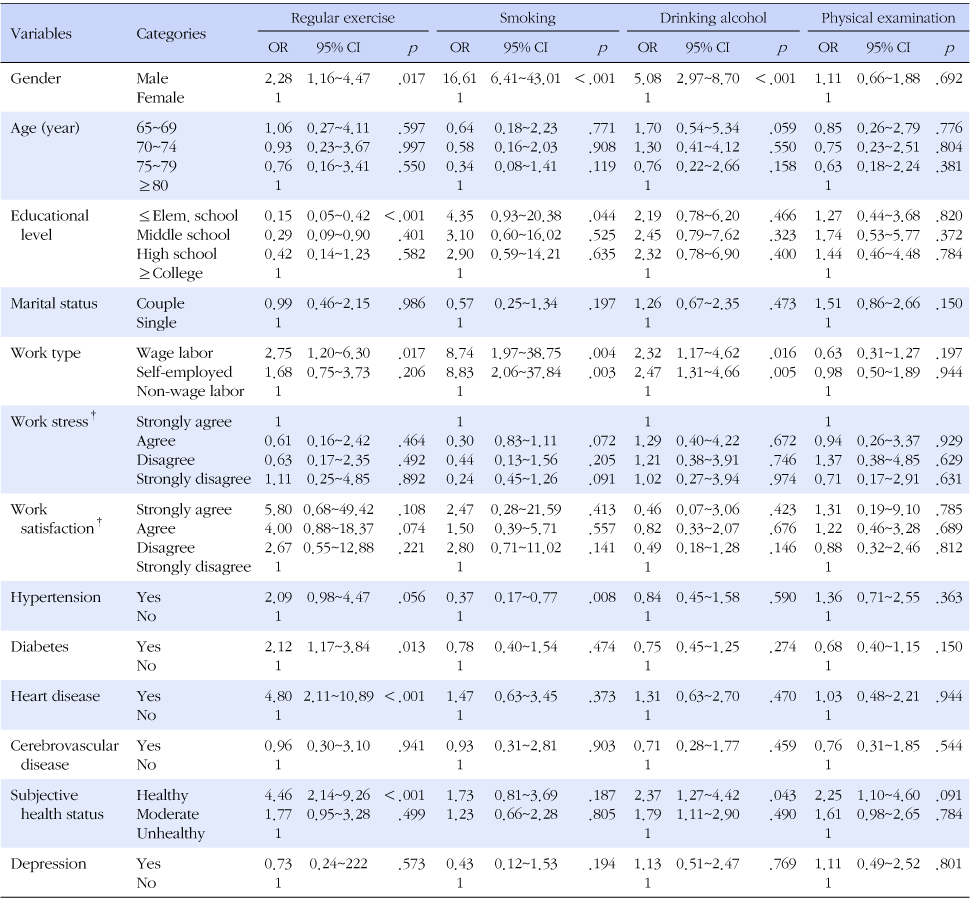References
1. Cho YJ. The effects of productive activities on elderly women's subjective well-being: An application of the demand-control-support model 2007. Seoul: Yonsei University; Unpublished doctoral dissertation.
2. Choi SJ, Chang IH. Senile welfare 2005. Seoul: Seoul National University Press;
3. Clark DO, Stump TE, Hui SL, Wolinsky FD. Predictors of mobility and basic ADL difficulty among adults aged 70 years and older. J Aging Health 1998. 10(4)422–440.
4. Dickson VV, Howe A, Deal J, McCarthy MM. The relationship of work, self-care, and quality of life in a sample of older working adults with cardiovascular diseases. Heart Lung 2012. 415–14.
5. Dickson VV, McCauley L, Riegel B. Work-heart balance: The influence of biobehavioral variables on self-care among employees with heart failure. AAOHN J 2008. 5663–73.
6. Eun Y, Song MS, Gu MO. Barriers to health behaviors in male and female elderly people in Korea. J Korean Acad Nurs 2008. 38(2)332–343.
7. Gu MO. A review of research on health promoting behaviors of Korean older adults. Perspect Nurs Sci 2006. 3(1)17–34.
8. Ha CK, Kim HS. The effect of elderly job projects satisfaction on life satisfaction: Focusing on mediating effect of self-efficacy. Soc Welf Policy 2009. 36(4)393–414.
9. Han GS. Perceived stress, mood state, and symptoms of stress of the patient with chronic illness. J Korean Acad Nurs 2003. 33(1)87–74.
10. Kim CG. Factors influencing health promoting behavior of the elderly: Perceived family support and life satisfaction. J Korean Community Nurs 2002. 13(2)133–143.
11. Kim DB, Chae SJ, Kim SU, Kim SJ. A study on factors which influence job satisfaction level among older people. J Welf Aged 2009. 45261–291.
12. Kim DB, Park EY. Study of the influence of the elderly females' productive activities on their life satisfaction. J Welf Aged 2007. 38339–358.
13. Kim JH. Complexity of productive ageing and tension and adaptation of old age. Korean J Sociol 2009. 43(5)101–132.
14. Kim MH, Lee DH. Factors related to health-promoting behaviors and chronic diseases in the elderly. J Korean Soc Health Educ Promot 2011. 28(2)99–107.
15. Kim SH, Lee SS. A study on self-esteem and life satisfaction of the elderly. J Korean Gerontol Soc 2009. 29(1)309–327.
16. Korea Institute for Health and Social Affairs. 2008 National survey of living status and welfare needs of the elderly 2009. Retrieved July 20, 2009. from
http://www.mw.go.kr.
17. Korea Institute for Health and Social Affairs. 2011 National survey of living status of the elderly 2012. Retrieved April 13, 2012. from
http://www.mw.go.kr.
18. Korea Labor Force Development Institute for the Aged. 2010 Survey of participating status of job creation projects for the elderly 2011. Seoul: Author;
19. Kweon CY, Kim SW, Lim JC, Lee HJ. Effects of work participation on the self-esteem of the elderly. J Korean Gerontol Soc 2007. 27(2)427–443.
20. Lee TW, Ko LS, Lee KJ. Health promotion behaviors and quality of life among community dwelling elderly in Korea: A cross sectional survey. Int J Nurs Stud 2006. 43293–300.
21. Lee JC, Park JS, Kim GH. Factors associated with the health promotion activities of the Korean elderly. J Korean Soc Health Educ Promot 2010. 27(2)121–139.
22. Meaning of Work International Research Team. The meaning of work: An international view 1987. London: Academic Press;
23. Ministry of Health and Welfare. The fourth Korea national health and nutrition examination survey (KIHANES IV-2) 2009. Seoul: Author;
24. Park HJ. The prevalence rate and the risk factors for chronic diseases among schoolteachers 2001. Seoul: Seoul National University; Unpublished master's thesis.
25. Seo GS. Health behavior in the aged and related variables. J Korean Gerontol Soc 2008. 28(4)1201–1212.
26. Statistics Korea. 2012 Economically Active Population Survey 2012a. Seoul: Author;
27. Statistics Korea. 2011 Causes of Death Statistics 2012b. Retrieved September 13, 2012. from
http://www.kostat.go.kr.
28. Yoon SD, Han GH. Productive activities and psychological well-being of the rural elderly in Korea. J Korean Gerontol Soc 2004. 24(2)57–77.
29. Walker LO, Best MA. Well-being of mothers with infant children: A preliminary comparison of employed women and home makers. Women and Health 1991. 1771–89.
30. Wynder EL, Fujita Y, Harris RE, Hirayama T, Hirayama T. The comparative epidemiology of cancer between the United States and Japan. Cancer 1991. 67(3)746–763.



